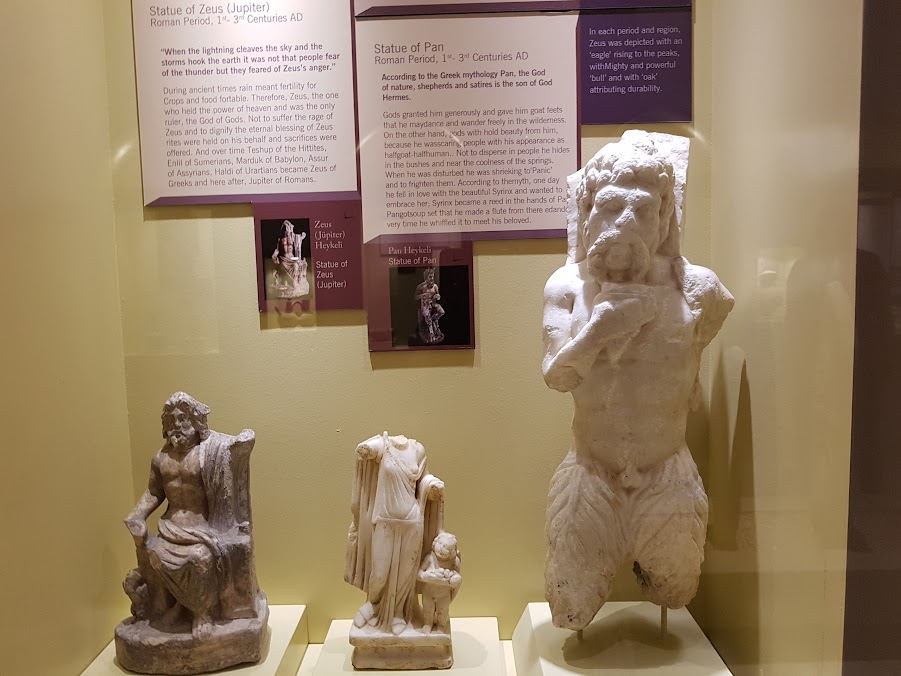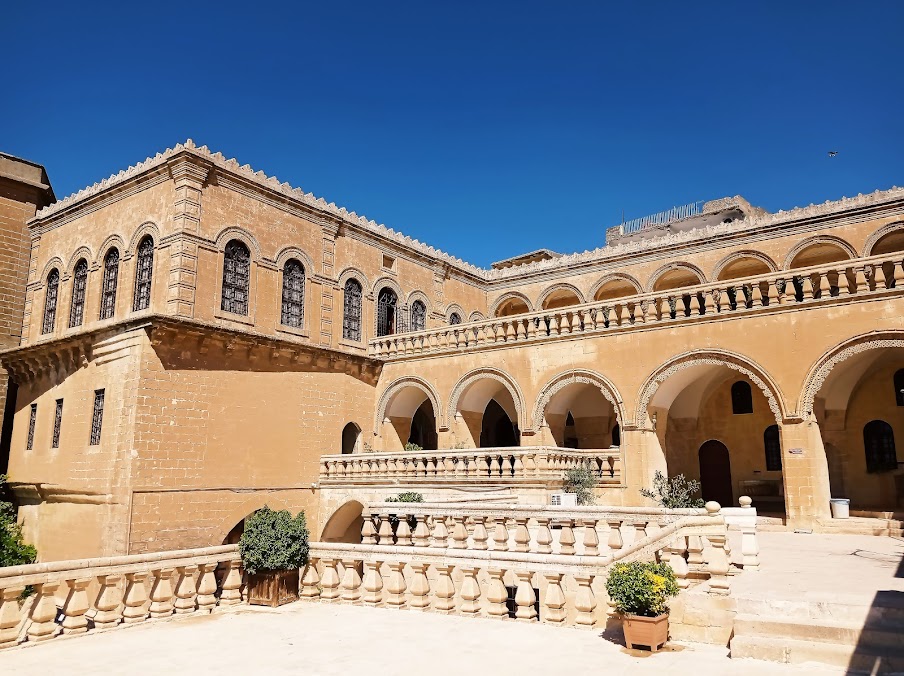During my visit to Mardin, one of the most impressive places I discovered was the Mardin Museum, which brings together history and culture. This museum not only showcases art and historical artifacts but also reveals the rich past and unique cultural fabric of Mardin. I learned a great deal about its history, the exhibited artifacts, and the value it adds to the city. I invite you to join me on a journey to explore both the Mardin Museum itself and the surrounding places worth visiting.

The History of Mardin Museum
The Mardin Museum is an important destination that highlights the city’s history and cultural richness. When I stepped into this museum, I immediately felt the excitement of embarking on a journey through the depths of history. Opened in 1995, the museum is housed in a historical mansion. Its captivating architecture reflects traces of the past and showcases the mastery of Mardin's local stone craftsmanship.
The artifacts displayed in the museum shed light on the region’s multicultural heritage. Spanning from ancient times to the Ottoman Empire, it features a wide range of exhibits. Thanks to the restoration efforts, visitors are not only provided with historical insights but also witness the preservation of this unique structure for future generations.
The Mardin Museum goes beyond being merely an exhibition space; it also aims to build a sense of local identity and sustain cultural heritage. During my time here, I followed the traces of the past while also witnessing the cultural diversity of the region. If you ever find yourself in Mardin, I highly recommend visiting this magnificent museum.

Artifacts to See at the Mardin Museum
During my visit to Mardin, I realized how important museum visits are for me. The artifacts I encountered at the Mardin Museum allowed me to embark on a journey into the depths of history. A wide variety of significant artifacts from different periods are exhibited here. Particularly, the stone artifacts from the Late Hittite period are captivating.
Sculptures and Stonework
The sculptures I saw in the museum demonstrate the remarkable craftsmanship of stonework. Among these sculptures, the figures representing the gods of the region and ancient civilizations caught my attention. Each sculpture tells a story and provides a visual journey into the region's past.
Archaeological Finds
Additionally, the archaeological finds, including historical utensils and everyday objects, stood out to me. These items provide insights into how people lived their daily lives. Especially the objects reflecting Mardin's traditional culinary culture helped me better understand local life.
Religious Artifacts
The religious artifacts in the museum are equally impressive. Objects belonging to various religions reveal the thousands of years of faith and cultural heritage of this land. Each piece serves as a bridge connecting the depths of the past to the present.
The Mardin Museum offers not only its exhibited artifacts but also the opportunity to embrace history and culture through these items. Visiting Mardin without experiencing this is simply incomplete.
Archaeological Excavation Hall
The Mardin Museum houses a hall where artifacts unearthed from archaeological excavations in and around Mardin are exhibited. This hall is dedicated to showcasing findings from various excavation sites.
The hall features discoveries from excavations conducted as part of the Ilısu Dam Project (Boncuklu Tarla, Havuz Mevki, Ilısu Höyük, Kumru Tarlası, Zeviya Kavla, Tatika, Kilokki Rabiseki), Kerküşti excavation (Halaf Period), Nusaybin Girnavaz excavation (Assyrian Period), Dara excavation (Roman Period), Midyat Aktaş Mevki Necropolis excavation (Byzantine Period), Nusaybin Mor Yakup Church excavation (Roman-Artuklu Period), and Mardin Castle excavation (Artuklu-Akkoyunlu-Ottoman Period). These artifacts aim to introduce visitors to the rich archaeological heritage of Mardin and its surroundings.
Faith Hall
The Faith Hall is a thematic exhibition space focusing on belief systems that originated in the Mesopotamian region and the artifacts associated with these systems. It emphasizes various faiths and their cultural heritage.
The Faith Hall delves into topics such as Mesopotamian mythology and early religions, Paganism, Christianity, Islam, burial traditions, and fertility and magic rituals. These themes provide visitors with information about how beliefs from different periods were practiced and expressed. These artifacts shed light on Mesopotamia's rich religious and cultural history, offering visitors a fascinating exploration experience.
Commerce Hall
Under the theme of commerce, the origins of trade in Mesopotamia, the first forms of currency, the invention of mathematics and writing, transportation, weaving, and the evolution of money are displayed in connection with artifacts that illustrate humanity's economic and commercial history throughout time.
One notable exhibit in this hall is the Sürekli Hoard, found during rescue excavations in Sürekli (Çıldız) Village, Kızıltepe. This hoard contains gold and silver artifacts from various civilizations, including the Abbasids, Ilkhanids, Ayyubids, Byzantines, Zengids, and Artukids, dating between the 9th and 14th centuries.
Life Hall
This hall reflects the social life of Mardin and Mesopotamian culture through themes of nutrition, adornment, and defense. Under the nutrition theme, the beginnings of agriculture in Mesopotamia, the emergence of pottery, and its development to the present day are presented alongside artifacts illustrating Mardin's culinary culture. Additionally, traditional musical instruments of Mardin are displayed, and visitors are shown the film "Sounds of Mardin," which highlights the intangible cultural heritage of the region.
Under the adornment theme, jewelry, clothing, and textile samples produced for attractiveness, social status, and protection from ancient times to the present day are exhibited, along with the traditions and culture of adornment in social life. Health and lighting themes are also emphasized.
Under the defense theme, ancient defense tools and weapons are displayed alongside the concept of war.
Forged Artifacts Hall
The final hall on this floor showcases counterfeit objects used in smuggling and fraud. This hall aims to raise awareness about historical artifact smuggling and counterfeit fraud through museum education. This unique practice in Turkey contributes to public awareness of counterfeit artifacts and smuggling.
Museum Administrative Building
Located northwest of the museum building, this registered structure reflects the traditional "Mardin house" architectural style of the 19th century. With a courtyard and two stories facing south, this L-shaped structure was restored by the Ministry of Culture and Tourism and the Mardin Governorship and opened in 2012.
The administrative building includes a specialized library, an art gallery, a conference hall, an archive, offices, a traditional handicrafts workshop, a photo studio, a prayer room, and administrative units.
Museum Specialized Library
Established in 2010, the library houses approximately 8,000 books and a digital publication archive with about 20,000 resources. It provides well-equipped services for researchers and students in fields such as archaeology, history, art history, architecture, philosophy, and mythology. As the most comprehensive resource center in the region for specialized fields, the library is an essential knowledge hub for researchers.
Museum Art Gallery
The Museum Art Gallery hosts more than 20 temporary exhibitions annually. Serving as a versatile hall, it is also used as a conference and performance space with a capacity of 150 people.
Restoration, Conservation, and Analysis Laboratories
Located in the western sections of the museum, the laboratories span an area of 250 square meters. They carry out restoration and conservation work on metal artifacts such as silver, copper, bronze, and iron, as well as ceramic, stone, glass, mosaic, wood, paper, leather, and textile artifacts. Restoration and conservation of approximately 40,000 artifacts in the museum's collection have been completed in these laboratories.
Additionally, the "Mardin Museum Analysis Laboratory," the first and only analysis laboratory in Turkey established within a museum, meticulously analyzes materials of cultural heritage and offers solutions for restoration processes.
Over 45,000 artifacts housed in the Mardin Museum are preserved in storages designed according to modern museology standards. These storages are equipped to facilitate research for researchers and students. As a center dedicated not only to exhibitions but also to societal development and well-being, the Mardin Museum strives to transfer a rich legacy from the past to future generations while promoting participation, respect for diversity, peace, and tolerance through its people-centered approach.

Where is Mardin Museum, What is the Entrance Fee?
The Mardin Museum, also known as the Mardin Archaeology and Ethnography Museum, is located in the city center. You can visit it every day of the week between 8:30 AM and 5:30 PM. The entrance fee to the Mardin Museum is 50 TL per adult. Museum Card holders can visit free of charge.

Must-See Places in Mardin
Mardin is like an open-air museum with its cultural richness and historical texture. There are many places to visit in this enchanting city. As I explore the city, I find myself captivated at every corner. First, you can admire the grandeur of Evliya Mosque, sometimes referred to as "Syriac Blue." It becomes especially stunning under the evening lights, creating a mesmerizing view.
Dara Ancient City
Located just outside Mardin, Dara Ancient City is a must-visit destination for history enthusiasts. As you walk among the remnants of the Roman period, you can feel the spirit of the past. The region's water cisterns and underground cities always leave a lasting impression on me.
Mor Gabriel Monastery
Mor Gabriel Monastery is known as one of the oldest Syriac monasteries not only in Mardin but also in the world. The serene atmosphere and fascinating architecture of this historic structure embrace every visitor. When you step into the monastery, you feel as if time has stopped.
In addition to these, enjoying the magnificent view of the city from Mardin Castle is a fantastic experience. While planning to visit all these places, I make sure to save some time for myself. Mardin is not only rich in history but also full of natural beauty and warm-hearted people.

 English
English Türkçe
Türkçe

@selimbakir
Sadece bina olarak bile gezmeye değer bir yapı. Şu anki modern müze binalarına göre küçük kalsada içerik olarak bölge tarihini ve kültürünü çok iyi anlatan bir müze. En az 2 saat ayırmak gerekiyor tam anlamıyla gezmek için.................................................................
@erdaltaylan7306
Müzenin binası gerçekten çok güzel içinde birde kilise var ama kapalıydı orayı göremedik müzenin içi dışı kadar ilgi çekici gelmedi çünkü çok az eser var ve odalar küçük daha çok kalıntı görmek isterdim. İki tane mezar var açık insan iskeletleri onlar güzeldi gerçekten baktıkça bu hayatın boş olduğunu düşünüyorsun yüz yıllar önce yasa ol aradan yüzyıllar geçsin birileri gelip mezarını sergilesin çılgınca geliyor insana. Mardin e mutlaka gelin ve buraları mardin kalesini ve eski Mardini gezin eski medeniyet ler hakkında bilgi sahibi olun.
@ahmetulker4677
Mardin müzesi , Mardin'e gidenleri kesinlik uğraması gereken müthiş bir müze. 1000 lerci yıllık tarih itinalı yapılan kazılar sonucu bulunarak insanların beğenisine sunulmuş. Gayretlerinden ötürü tüm arkeolog ve ekiplerine şükranlarımı sunuyorum
@muhammetarslan8574
Asgari ücretin doğuşu ve ilk paralar ilgi çekiciydi. Sahte eserler bölümü etkileyiciydi. Mezopotamya ayaklar altında ve içeri de geçmişi yaşıyorsunuz
@nilgulyapici7520
Takılara Bayıldım, renkler nasıl zevk ile yapılmış. Müzeyi mutlaka gezin manzarası da çok güzel oturup birşeyler içebilirsiniz.
@burcinsahin
Ozellikle çocuklar için tasarlanmış alan harika.Biz gittiğimizde sadece para basma atölyesi kullanıyordu ama diğerinin de çok keyifli olduğuna eminim.Çom büyük değil ama sonuçta tarihi eser arındıran tüm müzer görülmeye değer.Gelmeden önce arabayı meydandaki otoparka bırakmayı unugmayin.Müzeni alt tarafında bunan otopark du olabiliyor.Yoksa tüm eski Mardini inip geri çıkmanız gerekebilir.Çarşi tek yön
@muammerdogan8700
Müze tam eski Mardin meydanda ulaşım çok kolay terasında güzel bir manzarayla karşılaşıyorsunuz ve içeride tarihi sikkeler, silahlar, mezarlar vs var ve bunlar hakkında bilgilendirme yazıları mevcut Mardine gitmişseniz görmenizi tavsiye ederim. Görevliler ise kibarlar ve yardımcı oluyorlar.
@gezenanne
Müze tam eski Mardin meydanda ulaşım çok kolay terasında güzel bir manzarayla karşılaşıyorsunuz ve içeride tarihi sikkeler, silahlar, mezarlar vs var ve bunlar hakkında bilgilendirme yazıları mevcut Mardine gitmişseniz görmenizi tavsiye ederim. Görevliler ise kibarlar ve yardımcı oluyorlar.
@turgaysari9749
Eski Mardin meydanda ulaşım kolay lakin park olayı yok. Mekan çok güzel manzarası mükemmel tek eksik eser sayısı biraz az geldi bana onun dışında çok güzeldi. Müze kart geçerli. 18 yaş altı ücretsiz.
@gezendiva
Eski Mardin meydanda ulaşım kolay lakin park olayı yok. Mekan çok güzel manzarası mükemmel tek eksik eser sayısı biraz az geldi bana onun dışında çok güzeldi. Müze kart geçerli. 18 yaş altı ücretsiz.
@beyzanuraydinkeskin
Eski Mardin de yer alan, tarihi dokuyu hissettiren bir mekanda müze oluşturulması çok hoş olmuş, manzarayı izlemek bile cok keyifli, bilgilendirme yazıları yeterli. Müze giriş ücreti 25 TL, müzekart geçerli ancak tarihi dolmuş ise burada yenileme yapılmıyor. Sinevizyon gösterisi yapılmıyor izleyemedik, kilise ziyaret edilemiyor.